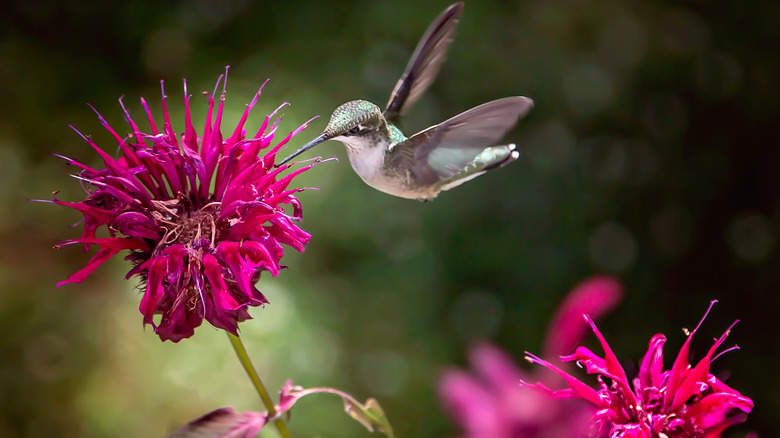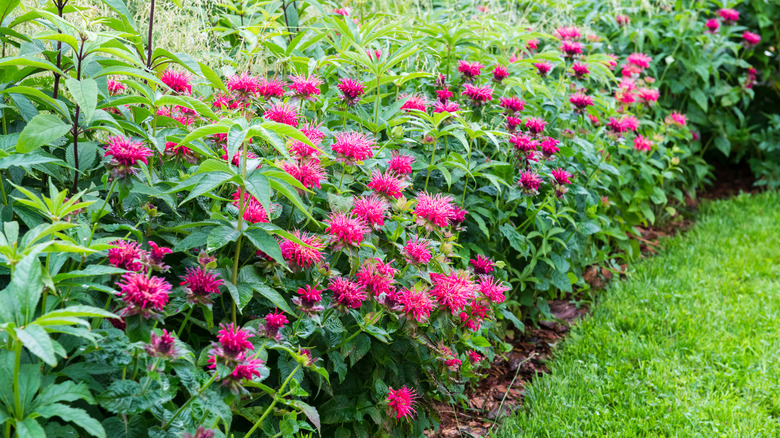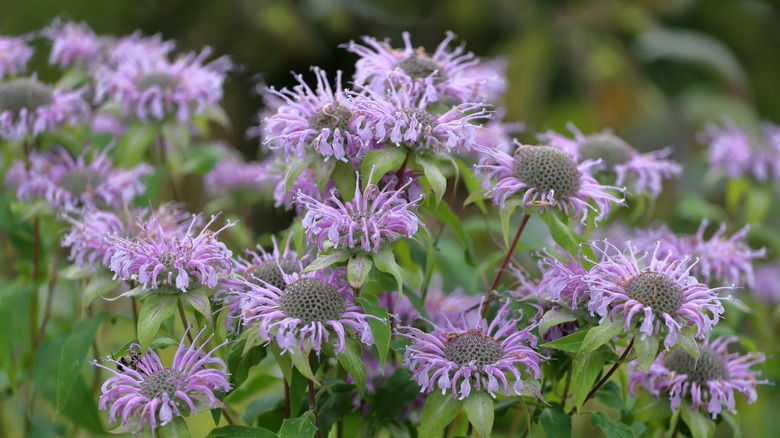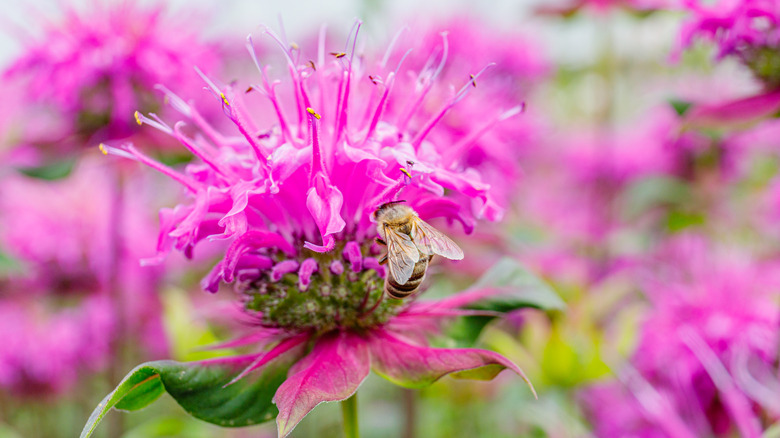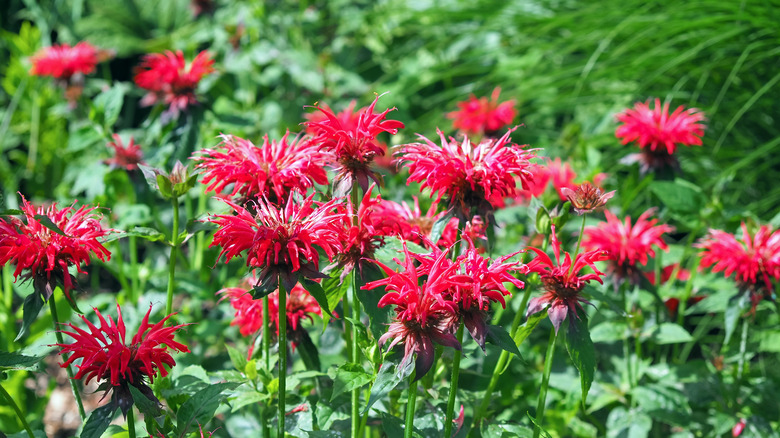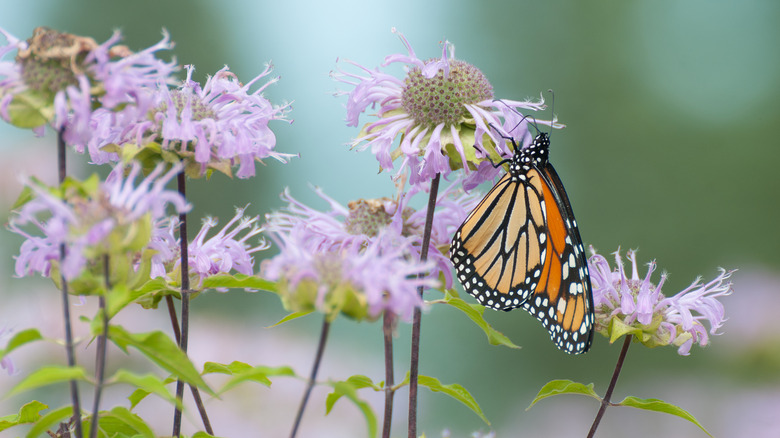How To Successfully Grow Bee Balm Plants
The Monarda plant, also known as bee balm, is very popular in gardens due to its innate ability to attract bees, hummingbirds, and butterflies. Bird lovers of all kinds are also known to keep this plant in their gardens, as various types of birds such as sparrows, goldfinches, and redpolls love to feast on the seed heads during the fall and winter months when the plant is not in bloom, according to Watching Backyard Birds.
Native to North America, the bee balm flower has an open, daisy-like shape, with tubular petals that grow in variations of white, red, pink, and purple, per Gardening Know How. Bee balm plants are perennial, coming back every year to add beautiful color to your garden. In addition to its brightly-colored beauty and its popularity among bird-watchers, bee balm is known to have been used medicinally by the Native Americans for centuries due to its antiseptic properties, per American Meadows. It is also said to be helpful for the treatment of nausea and depression and is popular among tea connoisseurs for its use in brewing various types of fragrant tea.
How to use bee balm in your garden
Bee balm's hearty nature and relatively easy means of growing help make it a popular feature in gardens. According to Gardening Know How, bee balm plants prefer direct sun and moist, rich soil, though they will tolerate shade just fine in the hottest summer months. Be aware that while your bee balm plant will likely be okay in shaded areas, it may not bloom as fully as it would in direct sun.
Plant it in any space in your garden that would benefit from bright color. Most varieties of bee balm are between 2 to 4 feet tall, which makes it a great candidate for the back of your garden, as the tall height of the plant will still allow the beautiful floral blooms to be seen while not blocking any of your shorter plants. There are also dwarf varieties of bee balm that typically only grow to be around 10 inches high, which make an excellent addition to container gardens or near the front of your flower bed. Due to its ability to quickly and aggressively spread, American Meadows recommends planting your bee balm near heartier plants, such as sedum or phlox, so as not to overwhelm smaller, more delicate plants in your garden.
How to grow bee balm
The Almanac says bee balm can be planted in either the fall or the spring and should be thoroughly watered at the time of planting. Deadheading dead blooms on your bee balm plant is incredibly important, as doing so will help encourage flower production and will allow new, fresh blooms to grow.
Growing bee balm is fairly easy as long as you keep the soil moist. Provide a good, multi-purpose fertilizer, and work it into the soil around the bee balm plant. According to American Meadows, you should grow your bee balm in soil that is rich in organic matter and will provide the moisture retention that your plant needs while still allowing for adequate drainage. While bee balm can grow adequately in soils of average fertility, dry soil for a sustained period of time will cause the plant to weaken and die. Adding 2 inches of organic-based mulch around your plant will help preserve moisture from rain and watering, especially since bee balm plants have shallow roots.
How to care for bee balm
If you want a bushier bee balm plant, Gardening Know How recommends pinching off the stem tips as new growth appears in the early spring. In late fall, they recommend cutting your plant down to just a few inches tall to promote fresh growth when the warmer months return. If you experience cold winters where you live, note that your bee balm plant may die completely to the ground during the winter without you having to cut it down. Fear not -– your bee balm will return in the spring.
The bee balm plant is susceptible to powdery mildew disease, which will appear as a gray, powdery dust on the buds and leaves. This is common in moist, cool weather. If your bee balm plant develops mildew, you can treat it with natural remedies or a basic fungicide spray. You can protect your bee balm plant from mildew by ensuring it receives adequate air circulation and by avoiding watering it from directly overhead.
Bee balm varieties
Most variations of bee balm are derived from Monarda didyma and Monarda fistulosa, per Fine Gardening. Over decades, hybridization between these two species has produced a large number of cultivars.
Per Florgeous, some popular types of Monarda, or bee balm, include:
-
'Beauty of Cobham' – This variant is more resistant to powdery mildew disease than other varieties and features scented green lanceolate leaves with a purple tinge and light, soft-looking lilac-pink blossoms.
-
'Dark Ponticum' –This variety is known for its pure purple to violet blooms and blue-green foliage that give an extra pop of color to gardens. It is regarded as one of the best performing native types of bee balm, especially once fully established.
-
'Gardenview Scarlet' – This variety features bright red blooms that measure about 4 inches each. This clump-forming perennial is known as one of the top-performing varieties of bee balm plants.
-
'Claire Grace' – This variety produces a massive number of light purple flowers and disease-resistant foliage.
-
Jacob Cline' – This is one of the best-known varieties of red bee balm and is known for its large, vivid red blooms and dark green, fragrant leaves.
Is bee balm toxic?
Bee balm is non-toxic to both humans and animals. In fact, according to Plant Addicts, the flowers and leaves are both edible, as the plant is a member of the mint family. It has been consumed throughout much of American history through its popular use in teas and medicines. While bee balm is non-toxic to pets, it is important to note that animals have a hard time digesting large amounts of plant material, so over-ingesting bee balm can lead to gastrointestinal upset in your furry friend.
According to American Meadows, bee balm was first cultivated for tea during the American Revolution when colonists were unable to purchase black tea from England. Though bee balm is often referred to as "wild bergamot," the name is misleading, as bergamot oil, used in the popular Earl Grey tea, is actually made from a citrus plant and not bee balm. Bee balm tea, often referred to as "oswego tea," is brewed from bee balm leaves or flowers and produces a soothing, minty flavor, per Get Busy Gardening; proving that bee balm is far more than just a beautiful plant.
How to repot bee balm
If you keep your bee balm in a pot instead of a garden, even temporarily, the roots can form a tight ball due to the plant's dense root system, per Epic Gardening. Dividing your bee balm prior to potting will be necessary to ensure it doesn't get too root-bound.
When dividing your plant, you will need to work quickly so the roots don't become dried out. Start by loosening the soil around the roots and gently use a shovel to get beneath them, carefully prying upwards until the plant comes free from its pot. Gently shake the plant and brush off as much loose soil as possible so you can get to the roots easier. Cut through the thicker roots with a pair of pruning shears, and then gently pry the two segments apart to divide them at the root. After you have divided your plants, cut off any rotten roots (the ones that look slimy) and immediately replant in new pots or in your garden to ensure your bee balm continues to thrive year after year.
